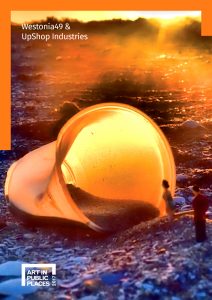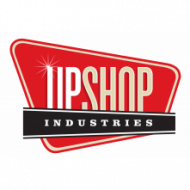
How can upcycling be a creative and collaborative act? In September 2017, a series of artworks appeared in Westgate Health Co-op (a co-operative community health clinic) and the Burn City Test Kitchen – both situated in the tiny (but pretty special) shopping strip in Vernon Street, South Kingsville – as part of Art in Public Places run by Hobsons Bay City Council.
Enlivened by the smell of wood-smoke and the buzz of a busy medical clinic, we hoped that the public would see the things we discard as waste differently and critically consider how we can all creatively extend the lifespans of discarded materials before they must go to landfill.
Upshop and Westonia 49 worked together to create object and image-based works from found, foraged, and salvaged objects and materials. Our methodology was marked by many questions, some of them quite specific to installing ‘art’ within a business, and others related to communicating the ‘value’ of upcycling, and of its creative outcomes.
Each work had to be mostly comprised of upcycled materials. Upshop focused on ‘sculptural assemblages’ repurposed and newly functional like Alfie. Westonia 49 figured out how photographs such as Salvaged, 2017, could both represent and embody sustainable practices and circular design thinking.
But how were we to communicate the value of the upcycling process to the public, especially when the works were not installed within a gallery environment with all the traditional conventions that tell us it is ‘art’, how to it art, and why it’s of value? How could each work be framed as public art when they were viewed within the semi-private spaces of a clinic and restaurant? Would we install in the front lobby of the clinic, the corridors to each office, the spaces restricted to only staff? Would the work be for sale? If so, why? What was their perceived value when they were hung in the wall of a restaurant rather than, say, an experimental artists-run space in the city?
Discovering and experimenting is what we value most from this experience: Working on-site with staff and the limits of business hours, figuring out ways to hang works with minimal intervention, seeing the delight when a staff member realised that what was hanging on the wall was not only ‘art’ but that it was constructed from rescued materials and saved objects. A medicine cabinet, for example, was nothing out of the ordinary for a medical clinic. But when hung on a wall, with the glass vials arranged in a particular pattern, it was familiar but not functional – that meant people at this old object anew. We did use descriptive text, printed using the typeface and lovely thick, embossed cards gifted from Excell Press and tried to gives each work a story, of what it once was.
We did decide to put prices on each ‘work’. Some found a home like On the Moors that hangs in a baroque-inspired bedroom in Coburg. And The Toolkit was purchased by the Clinic’s board, and remains installed in the staff kitchen. Other works await new ‘homes’ at Upshop.
And what we are most proud of is that, at every staff and Board meeting of the Clinic, the old Butchers Bike is present. Treasured as a mode of transportation in the 1920s, this bike was found in the scrub of Merri creek and gifted to Mario by a ‘fella he knew who was once President of the Brunswick Bike Shed”. Lovingly refurbished by Mario, what was discarded as trash has returned to its rightful place – in a medical clinic that was once an old butchers shop!
Thank you to….
Mary-Anne Perry, the manager of Westgate Health Co-op medical clinic &
Raphael and Steve, the owners of Burn City Smokers, for their enthusiasm and support.
Nancy Laing for being a willingly photographed observer.
Bonnie Dalton and Hobsons Bay City Council.












